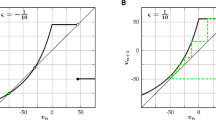Abstract
This paper describes a general nonlinear dynamical model for neural system identification. It describes an algorithm for fitting a simple form of the model to spike train data, and reports on this algorithm's performance in identifying the structure and parameters of simulated neurons. The central element of the model is a Wiener-Bose dynamic nonlinearity that ensures that the model is able to approximate the behaviour of an arbitrary nonlinear dynamical system. Nonlinearities associated with spike generation and transmission are treated by placing the Wiener-Bose system in cascade with pulse frequency modulators and demodulators, and the static nonlinearity at the output of the Wiener-Bose system is decomposed into a rectifier and a multinomial. This simplifies the model without reducing its generality for neuronal system identification. Model elements can be characterised using standard methods of dynamical systems analysis, and the model has a simple form that can be implemented and simulated efficiently. This model bears a structural resemblance to real neurons; it may be regarded as a connectionist “neuron” that has been generalized in a realistic way to enable it to mimic the behaviour of an arbitrary nonlinear system, or conversely as a general nonlinear model that has been constrained to make it easy to fit to spike train data. Tests with simulated data show that the identification algorithm can accurately estimate the structure and parameters of neuron-like nonlinear dynamical systems using data sets containing only a few hundred spikes.
Similar content being viewed by others
References
Bayley EJ (1967) Spectral analysis of pulse frequency modulation in the nervous system. IEEE Trans Biomed Eng 15:257–265
Bell CC (1986) Electroreception in Mormyrid fish: central physiology. In: Bullock TH, Heiligenberg W (eds) Wiley, New York, pp 423-453
Citron MC, Marmarelis VZ (1987) Applications of minimum order Wiener modelling to retinal ganglion cell spatiotemporal dynamics. Biol Cybern 57:241–247
Davis MHA, Vinter RB (1985) Stochastic modelling and control. Chapman and Hall, London New York
Di Stefano JJ, Stubberud AR, Williams IJ (1976) Feedback and control systems. McGraw-Hill, New York
French AS, Korenberg MJ (1991) Dissection of a nonlinear cascade model for sensory encoding. Ann Biomed Eng 19:473–484
Hamming RW (1983) Digital filters, Prentice-Hall, Englewood Cliffs, NJ
Hunter IW, Korenberg MJ (1986) The identification of nonlinear biological systems: Wiener and Hammerstein cascade models. Biol Cybern 55:135–144
Korenberg MJ (1988) Identifying nonlinear difference equation and functional expansion representations: the fast orthogonal algorithm. Ann Biomed Eng 16:123–142
Korenberg MJ, French AS, Voo SKL (1988) White-noise analysis of nonlinear behaviour in an insect sensory neuron: kernel and cascade approaches. Biol Cybern 58:313–320
Lee YW, Schetzen M (1965) Measurement of the Wiener kernels of a nonlinear system by cross-correlation. Int J Control 2:237–254
Ljung L (1987) System identification: theory for the user. Prentice-Hall, Englewood Cliffs, NJ
Marmarelis VZ (1989) Signal transformation and coding in neural systems. IEEE Trans Biomed Eng 36:15–24
Marmarelis PZ, Marmarelis VZ (1978) Analysis of physiological systems: the white noise approach. Plenum, New York
Marmarelis VZ, Citron MC, Vivo CP (1986) Minimum-order Wiener modelling of spike-output systems. Biol Cybern 54:115–123
Paulin MG (1992) Digital filters for firing rate estimation. Biol Cybern 66:525–539
Paulin MG, Bodznick D, Montgomery JC (1990) White noise analysis of electroreceptor afferent dynamics in the carpet shark. Proc NZ Physiol Soc 10:10
Pellionisz A, Llinas RR (1979) Brain modelling by tensor network theory and computer simulation. The cerebellum: distributed processor for predictive coordination. Neuroscience 4:323–348
Press WH, Flannery BP, Teukolsky SA, Vetterling WT (1988) Numerical recipes in c. Cambridge University Press, Cambridge, UK
Rumelhart DE, McClelland JL (eds) (1986) Parallel distributed processing. MIT Press, Cambridge, Mass
Searle J (1984) Minds, brains and science. Harvard University Press, Cambridge, Mass
Author information
Authors and Affiliations
Rights and permissions
About this article
Cite this article
Paulin, M.G. A method for constructing data-based models of spiking neurons using a dynamic linear-static nonlinear cascade. Biol. Cybern. 69, 67–76 (1993). https://doi.org/10.1007/BF00201409
Received:
Accepted:
Issue Date:
DOI: https://doi.org/10.1007/BF00201409




